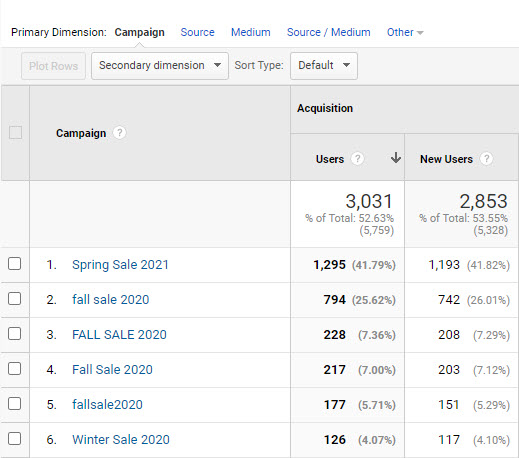As a digital marketing agency, CTRL+ALT Digital doesn’t believe that our job is done when we’ve converted a prospect into a customer. We know that in a highly competitive digital marketing world, we need to take it one step further. That’s why we regularly analyze client data to determine what works, what isn’t working, and what needs to change.
It’s easy to use free tools like Google Analytics to get a basic idea of how a website is performing, but we know the importance of properly setting up source tracking for our clients to ensure that we have a more complete picture of website and campaign performance.
We receive a lot of questions about source tracking so we’ve put together this guide to help clients understand what needs to be done to effectively and accurately set up source tracking.
Definitions
In this blog, we assume you already have Google Analytics installed and know the basics. As you’ve explored the interface, you’ve probably come across the Source, Medium and Campaigns reports but you may not understand the differences. We'll break it down below.
Medium
This bucket notes the handful of categories for how traffic got to your website. This is how you find out if traffic came from paid ads (“cpc”), SEO (“organic”), other websites (referral) and more.
Source
This is a more detailed breakdown of your website’s traffic. The source may include the domain of a referring website or the name of a search engine or social media platform.
Campaigns
This is the name of a specific marketing campaign that generated traffic to your website. This is typically a value that is generated manually.
UTM
This is a legacy term from before Google Analytics existed. It stands for “Urchin Tracking Module” and Google has used this since it acquired the Urchin web analytics platform in 2005.
Adding Source Tracking
We often hear people ask about adding source tracking to Google Analytics but that’s not how source tracking works. Google Analytics naturally accepts source tracking, it simply has to be properly included in the URL that leads to your site. This is done via query string parameters (QSPs) with “utm_” variables. They look like this:
https://yoursite.com/landing_page?utm_medium=email&utm_source=newsletter&utm_campaign=newservices2021
The visits that arrive at your site with that link will have “email” as the medium, “newsletter” as the source, and “newservices2021” as the campaign.
If you’re in control of the links being sent to your website, all you have to do is append the utm_ variables to the URL via query string parameters and Google Analytics does the rest.
If a third party controls the link, you’ll need to work with them to implement source tracking by editing the link and adding the correct query string parameters.
Source tracking is not always manual. Some platforms like Google Ads will automatically add source tracking, although they do allow you to override their automated tracking parameters.
Pro tip: If you do try to override Google Ads automated source tracking, be sure that you’ve checked the admin panel in Google Analytics and ensured that Manual Tagging for Google Ads is enabled.
Tips for Query String Parameters
QSPs are easy to understand once you’ve worked with them a bit. Google Analytics even provides a tool that helps you build QSPs with proper source traffic. Because their Campaign URL Builder tool makes it so easy to build QSPs, we’ll stick to providing tips that ensure your source tracking tags are effective.
UTMs Values Should Be Simple And Clear
There’s no need to create complicated UTM values. Campaign values may need to be analyzed months or years down the line. You’re better off naming a campaign “summerdiscounts2021” than “sd21” because it’ll be easier to analyze at a glance.
UTM Values Should Be Short
Simply put, shorter values are easier to understand and less prone to errors. When the Google Analytics tracking pixel fires, it sends a lot more information than just source tracking to Google Analytics. This is all carried by a URL string with additional query string parameters, which are all automatically generated by Google. Because there is a 2000 character limit for URLs, if you make your source tracking values much longer than necessary, it’s possible to exceed the limit and risk losing valuable data in Google Analytics.
Source Tracking Is Case Sensitive
“SummerDiscounts2021” and “summerdiscounts2021” will appear as two separate campaign values in Google Analytics by default. Therefore, we recommend using consistent capitalization in your UTM values to ensure sources, mediums, campaigns and more are properly grouped.
Campaigns Should Be Named Consistently
Campaigns can exist across a variety of mediums and sources, so to understand campaign performance at a glance, make sure each unique campaign has the same name regardless of which source it falls under. “SummerDiscounts2021email” and “SummerDiscounts2021facebook” would show up as two separate entries, so it’s better to simply name your campaign “SummerDiscounts2021” so all traffic generated will fall under that line item in Google Analytics. You can always break it down into different sources or mediums later.
Summary
Source tracking doesn’t need to be confusing or intimidating. Even if you don’t have an analytical background, hopefully this guide highlights how simple source tracking and query string parameters can be if you follow a few simple rules. With that said, there are always exceptions to rules and more complex tracking needs that may require more expertise. If you need more help, get in touch with the analytics experts at CTRL+ALT Digital we so we can help with your tracking needs.




